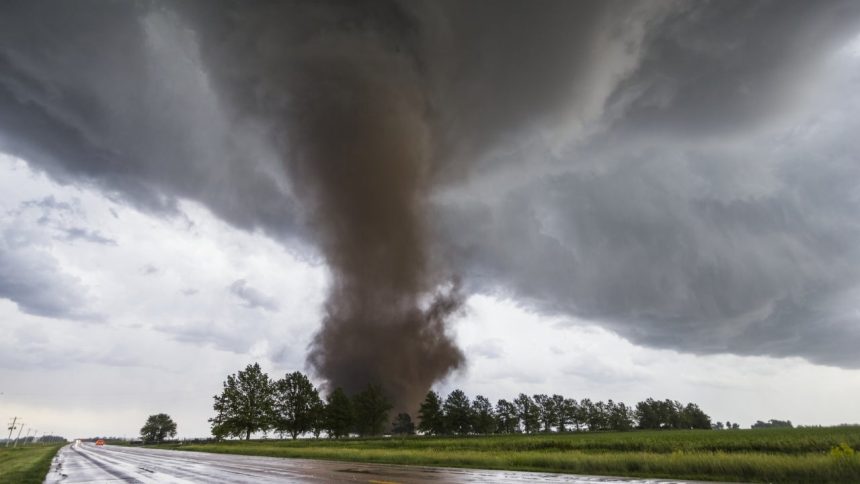Mike Hollingshead/Getty Images
2022 was a rough year in the United States for several reasons, not the least of which was tornadic activity. 1,240 tornadoes were reported in 2022, and the storms resulted in 24 deaths. While this is down from 1,314 twisters in 2021, it’s still sharply up from 1,082 in 2020. In fact, the U.S. hasn’t reported fewer than 1,000 tornadoes in seven years, since 2016. While Mississippi, Texas and Alabama were the worst states for tornadoes in 2022, these storms can and do occur in most areas of the country. Understanding your area’s risk level for tornadic activity could help you lessen the risk of property damage and injuries.
The worst states for tornadoes
There were ties in one ranking position for the number of tornadoes per state in 2022, so this list actually includes 11 states this year. Although often associated with the central part of the United States, tornadic storms can develop and cause destruction just about anywhere in the country, and it would seem that tornadoes are happening more often in the Southeast than they were previously. Understanding your state’s tornado risk could help you prepare yourself, your family, your home and your vehicles for potential damage. So what state has the most tornadoes?
- Mississippi: Mississipii recorded an astounding 184 tornadoes in 2022 — sharply up from 92 in 2021 — but thankfully only one death.
- Texas: Texas had more tornadoes in 2022 than in 2021, but the massive increase in Mississippi caused the Lone Star State to rank second this year. Texans saw 160 tornadoes in 2022.
- Alabama: 117 tornadoes, resulting in three deaths, were recorded in Alabama in 2022. The second-costliest tornado damage on record in the U.S. occurred in Tuscaloosa in April 2011, causing $9.7 billion in property losses (2022 dollars).
- Minnesota: The Land of 10,000 Lakes recorded 77 tornadoes in 2022, a massive increase from just 37 in 2021.
- Florida: Florida’s wild weather spawned 73 tornadoes in 2022. Two people lost their lives. Tornadoes are not uncommon during hurricanes, so Florida homeowners should be weather aware.
- Kansas: Traditionally a tornado-prone state, Kansas saw 68 tornadoes in 2022 and thankfully, no one lost their lives. 2021 had 46 tornadoes though, so the state still fared worse last year.
- Louisiana: The Pelican State faced 61 tornadoes in 2022, versus 50 in 2021, and four people were killed.
- Arkansas and Georgia: Both Arkansas and Georgia recorded 56 twisters in 2022. No one lost their life in Arkansas, but one death was recorded in Georgia.
- Iowa: Another traditionally risky state, Iowa had 53 tornadoes in 2022 and the most deaths of the top-10 states at seven. The state had 70 tornadoes in 2021 though, so the overall number of storms did drop last year.
- Colorado: 39 tornadoes were confirmed in Colorado in 2022, but thankfully didn’t result in any deaths. Colorado recorded 48 tornadoes in 2021, although it still ranked in 10th place last year.
The states with the fewest tornadoes
While tornadoes occur in all 50 states and Washington, D.C., several states experience minimal tornadic activity in an average season. These states recorded no tornadoes in 2022:
Additionally, these states recorded three or fewer tornadoes last year:
While these states record relatively few tornadoes on average, each season is different. Even states that aren’t considered to be high-risk for tornadoes can experience dangerous convective storms that spawn tornadoes and cause widespread property damage.
Which states are in Tornado Alley?
Tornado Alley is a nickname given to a region in the U.S. where tornadoes are common. Tornado Alley generally begins in the Southern plains and extends northward through the upper Midwest to the Canadian border. States commonly associated with Tornado Alley include Texas, Kansas and Nebraska.
However, Tornado Alley is not an official meteorological designation, and it’s common for states outside of the central U.S. to experience tornadoes. The National Severe Storms Laboratory (NSSL) notes that tornado hotspots tend to move depending on the season. In the cooler parts of the year, the Southeast experiences more tornadoes than the rest of the country, but that shifts to the southern and central parts of the country in spring. The risk then moves again to the northern plains and Midwest in summer.
Does homeowners insurance cover tornadoes?
Most standard homeowners insurance policies cover tornado damage for the structure of your home, outbuildings and your personal belongings. Your policy will also likely cover damage from fallen trees that are blown onto your home during a storm.
As a result, you may not need to purchase a separate policy for tornado insurance coverage. However, every policy varies in its coverage, so reviewing your policy with your insurance professional for these protections can be a good idea. Your home insurance policy might not offer enough coverage if you live in one of the worst states for tornadoes. Additionally, every property carrier and every policy is different, so tornado damage could be excluded from your policy. In that case, you may need to seek out a separate policy to cover tornado damage.
In addition to heavy winds, the intense convective storms that spawn tornadoes often cause floods. Unlike tornado and wind damage, flood damage is not covered by standard homeowners insurance. In order to be protected by flood insurance, you will likely need to purchase a separate flood policy underwritten by the National Flood Insurance Program (NFIP). Flood coverage is also available through many private insurers and many property insurers offer flood coverage as an endorsement on standard home policies.
Prepping your home for tornadoes
In addition to making sure your home insurance covers you in the event of a tornado, there are some things you can do before and after a storm to mitigate your risk to minimize damage. These tips can help you prepare for a natural disaster by physically safeguarding your home and belongings. If you live in an area where tornadoes are common, you may want to:
- Strengthen your garage by reinforcing it with vertical bracing.
- Reinforce your roof with hurricane clips.
- Secure your windows with plywood and clips.
- Remove branches and trees that are on the verge of breaking or are overhanging your roof.
- Keep important paper records in a secure location and in waterproof containers.
- Invest in a storm-proof safe room.
These preparations and safeguards can make an enormous difference should a disaster strike. If the worst does happen, having pictures of valuable belongings and the inside and outside of your home can be helpful if you need to file a property insurance claim. Preparing a detailed home inventory of your belongings could also be beneficial. Such an inventory should be stored in the cloud or on a flash drive for quick access after a storm.
Frequently asked questions
-
-
There is no such thing as a vehicle tornado policy. However, if you have comprehensive coverage on your car insurance policy, you’ll likely have coverage for the damage that a tornado could cause. Comprehensive coverage is designed to pay for non-collision damages, like wind, hail and other storm damage.
-
The best homeowners insurance company will vary depending on your individual needs and rating factors. Shopping around and comparing home insurance quotes from multiple carriers before purchasing a policy might help you find the right fit for your situation. A licensed insurance professional can help you through the process of obtaining quotes and securing coverage.
-
Experts typically recommend that homeowners purchase enough home insurance to cover the entire dwelling (the actual structure of your home) if a tornado or other covered peril destroys it. You may also want to consider personal property coverage. Other coverage types that could be helpful include other structures coverage, medical payments coverage and water backup coverage. A licensed insurance professional can help you choose coverage for your specific needs.
-
Home insurance will probably cover temporary housing. Most standard home insurance policies include additional living expenses coverage, which is designed to pay for the expenses you could incur if you aren’t able to stay in your home after a covered loss. For example, if a tornado damages your home to the extent that it is unlivable, your home insurance could pay for a home rental, hotel room, restaurant meals, pet boarding and other necessary expenses up to your policy limit.
-
Read the full article here
















